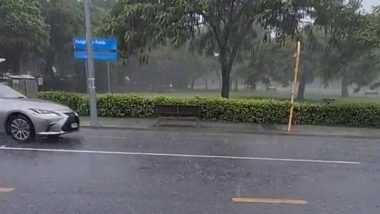Shimla, November 30: A technical team, which was tasked with assessing the cause and impact of floods and landslides in Himachal Pradesh, has attributed the calamities to overburdening of the surface and lack of controlled drainage in Shimla and other parts of the state. The technical committee has revealed further in its report that the heavy precipitation in floodplains caused heavy damage to houses near rivers.
Significantly, the experts also suggested prior geological assessment for any developmental activities in the hills to prevent such damages in future.
Speaking to ANI on Thursday, SS Randhawa, the chief coordinator of the technical committee, said the committee has submitted the report to the government. He said this committee was constituted to conduct a scientific study of the floods and the damage they inflicted on the state in July and August in the state capital, Shimla. Himachal Pradesh Monsoon Mayhem: 199 People Dead and 31 Missing Till Now, Estimated Loss to Infrastructure Stands at Rs 6563.58 Crore.
"The Committee was constituted to study the scientific assessments of the impact and causes of floods and damages in Shimla. Overall there were heavy and large numbers of landslides and floods; over 5000 small and big landslides were reported during the monsoon here. The geological assessment should be the main component for any kind of developmental activities. Prior assessment of geology is necessary and also needs to be studied the major structural thrust which could cause damages. A prior assessment and mitigation is necessary in the mountains," Randhawa told ANI.
There were eight-member multi-disciplinary committees, which included members from the state geological department, engineers from the PWD, and experts from science and technology department.
"With the weathering process, construction and other activities, the debris flow was unchecked, exposing the rock underneath. In Summerhill, the old buried channel was filled up and it became a structural depression. In the antimonic areas in the mountains, the straight segments are structurally controlled and are either formed due to tectonic disturbance or erosion. That was also one of the reasons why the area was fragile and heavy debris flow converted into landslides," Randhawa said.
He said nearly 20 sites were studied in Shimla city and suburbs, revealing that an overburdening of the debris accelerated the damages. He said that a lack of controlled drainages in the city was also one of the major causes.
"The thickness of the material and debris accelerated with the passage of time. We have studied 15 to 20 sites and the cause was either debris or the open drainage system. In Krishnanagar, there is no controlled drainage, The material has eroded due to overburdening of the surface. The water seeps and continues infiltration, which results in debris flow.," Added Randhawa.
The experts have also revealed that the encroachment in the flood plains were also the reasons as the heavy precipitation resulted in floods in the rivulets and Rivers. " In the Kullu region in the Beas River there was heavy flow of water . There was heavy precipitation, the rivers were flooded and water flow increased in rivers and changed the course. There should not be any construction activity in plains; the construction activities should be done far behind the terraces," said Randhawa. Himachal Pradesh Rains Videos: Landslides, Flooding, Overflowing Rivers, Incessant Rainfall Unleashes Deaths and Devastation Across State.
"Two systems -- mountain depression and also the Western Disturbance -- collided between July 9 and August 13, causing heavy rainfall in western parts of the Himalayan region. In Shimla, the slopes, geology, play a major role. The pathological variations structures also play an important role." Randhawa added.
(This is an unedited and auto-generated story from Syndicated News feed, LatestLY Staff may not have modified or edited the content body)













 Quickly
Quickly





















